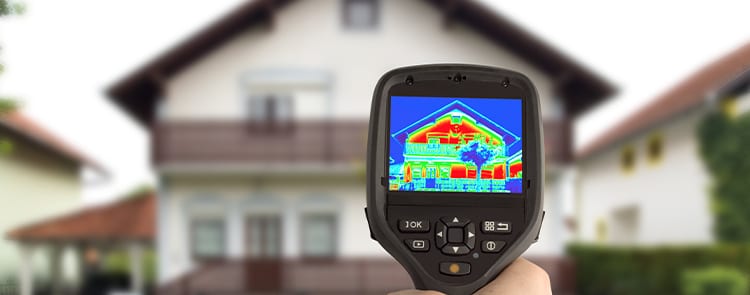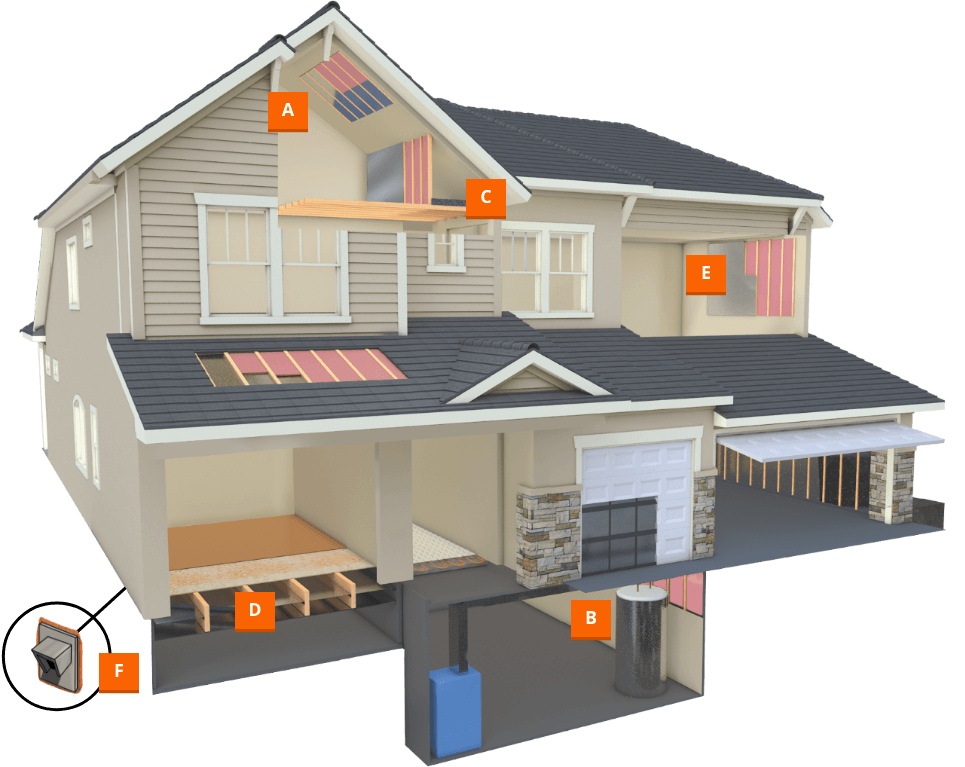Blogs
Keep Air Conditioned Air Where It Belongs: Inside Your House
5/19/2020

Beyond attics and walls, imagine a home insulation solution that creates a snug “housing envelope” controlling heat, air, moisture, and sound. Control the climate inside your home with the right insulation and the right company to give you peace of mind. Even the smallest gaps and cracks can be filled with spray foam insulation.
Insulate Your Whole Home
Having the correct amount of insulation can help you maintain a comfortable temperature throughout your home and help save money on your energy bills – plus, prevent major issues like ice dams in the winter.

- A = Attic – Protects your home from cold, heat, and humidity. Save on power bills.
- B = Basement – Helps reduce heating costs and prevent damage caused by moisture.
- C = Ceiling – Provides even in-home temperature. Prevents mold and moisture issues.
- D = Crawlspace – Improves moisture control. It helps reduce exterior noise.
- E = Walls – Improves moisture control. It helps reduce interior and exterior noise.
- F = Gaps & Cracks – Seals gaps for airtightness. Prevents mold, pests, and noise.
Keep Your House Cool This Summer
The two biggest culprits leading to both heating and cooling loss are air leakage and poor insulation. Follow these three steps to prevent air leakage in your home:
- Close up attic air leaks. In the average home, statistics show that 85 percent of a house’s air loss is through the attic. About one-third of the heat loss is through the ceiling into the attic. And most of that loss comes from air leaks caused by unblocked walls, gaps in drywall, and cracks around light fixtures, plumbing pipes, chimneys, access hatches, and other ceiling penetrations. The temperature in your attic is very different than that of any other place in your home and this causes greater air movement through these gaps, cracks, or holes. Air leaks can be tough to stop. You have to climb into your attic, pull or rake back insulation, and plug the leaks using foam, caulk, and other methods. Plus, low roof angles make air leaks difficult to reach.
- Measure your attic insulation level. While you’re in your attic, you’ll also want to check the depth of your attic insulation. Building codes require about 18 to 24 inches of fiberglass or cellulose. Add more if you have less than 12 inches and have had ice dam problems in the past. Blown-in cellulose, fiberglass, or closed cell spray foam are usually better than hand-placed batts because they fill more tightly around rafters, joists, and other obstructions, leaving fewer gaps. It’s usually worth hiring a professional for this job; you probably won’t save much by doing it yourself.
- Add roof ventilation and soffit vents. Attic ventilation draws in cold outdoor air and flushes out warmer attic air, cooling the attic and the roof in the process. The minimum ventilation area (size of the openings) should be about 1 sq. ft. of vent per 300 sq. ft. of ceiling area (attic floor area), when half the vent area is low on the roof and half is high. Actually figuring all this out is a bit complex; you’d have to examine your existing vents to find the area of each vent. This is easier said than done. Also be sure that all vents and soffits are clear from debris and blockages like old insulation, leaves, bugs, or leaves. Not all attic ventilation systems are the same. This can make it even more confusing to ensure yours is working correctly. Ensure your ventilation system is correct for the application it is configured for before making changes to it.
We Have a Solution for You
If you’ve experienced any of the following, you’re a prime candidate for an air leakage test:
- Hot air and cold spots
- Unreasonable fluctuating energy bills
- Drafty areas
- Upstairs that is 10 degrees warmer than downstairs in the summer
- Ice dams on your roof
- Moisture spots on drywall
- Mold-like substances
- Frosty windows
- Critters, pets, unusual spiders, box elder bugs, Asian beetles, stink bugs
Our air leakage test provides a full comprehensive inspection from the top of your attic to the bottom of your basement. Utilizing our newest and top-of-the-line inspection tools, we’ll calculate the exact amount of air leakage in your home to determine next steps customized to your home.
Take the First Step & Call Today
If your insulation doesn’t measure up and you’ve experienced any of the items noted above, give Service Legends a call today at 515-657-6634. We’d be glad to answer any of your questions and even help you choose the right type of insulation for your home.
515-657-6634Request Appointment Online
Return- January 2024
- October 2023
- September 2023
- August 2023
- January 2023
- December 2022
- November 2022
- October 2022
- September 2022
- August 2022
- July 2022
- June 2022
- May 2022
- April 2022
- March 2022
- February 2022
- January 2022
- May 2021
- November 2020
- October 2020
- September 2020
- July 2020
- June 2020
- May 2020
- March 2020
- February 2020
- December 2019
- November 2019
- September 2019
- May 2019
- April 2019
- January 2019
- December 2018
- November 2018
- October 2018
- July 2018
- October 2016
- September 2016
- August 2016
- July 2016
- June 2016
- May 2016
- April 2016
- March 2016
- February 2016
- January 2016
- December 2015
- November 2015
- October 2015
- September 2015
- August 2015
- July 2015
- June 2015
- May 2015
- April 2015
- March 2015
- February 2015
- January 2015
- December 2014
- November 2014
- October 2014
- September 2014
- August 2014
- July 2014
- May 2014
- March 2014
- February 2014
- January 2014
- December 2013
- November 2013
- October 2013
- September 2013